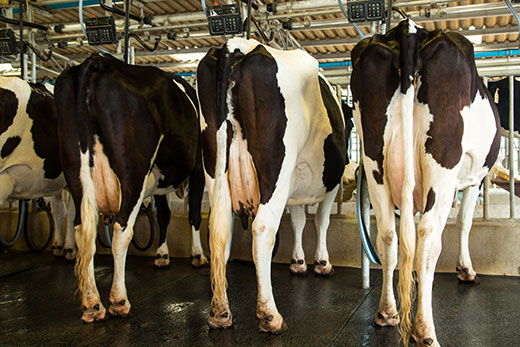Increasing use of palm kernel as a supplementary feed could affect Fonterra's ability to process milk to meet customers' requirements, says group director of co-operative affairs Miles Hurrell.
'Large quantities of any feed can affect the composition of milk and how consumers perceive our products.
The consumption of PKE is affecting milk processing.
'We've seen a significant increase in the use of PKE during the last few years, and if this continues it could affect composition to the point where we can't process our milk to meet customers' requirements,” says Miles.
He is responding to questions from SunMedia about the use of palm kernel, also known as PKE, and its impact on milk quality and the cost of dairying.
Last year Fonterra called for farmers to limit PKE consumption to about 3kg per cow per day.
'Our PKE guideline is a voluntary guideline and we are still talking with our farmers to understand how it's working in practice within a range of different farming systems.
'Anecdotally, it does appear that this summer's grass growth, together with a low milk price environment, is encouraging farmers to reduce their use of supplementary feeds, including PKE,” says Miles.
'In a low milk price environment, the use of imported supplementary feeds does become uneconomic for many farmers and we would certainly encourage farmers to consider grass as a way of lowering costs.
'In general, we know that in international markets we get a premium for our milk because of our pasture-based system. We see reduced PKE use as a positive step toward protecting that grass-fed reputation and our product integrity.”
DairyNZ scientist Dr Jane Kay Palm Kernel says the digestibility of PKE is lower than some feeds such as spring pasture, maize silage or maize grain, due to the low digestibility of its fibre fraction.
Estimates for PKE digestibility in a cow's rumen range from 50 per cent to 60 per cent.
'However, this does not accurately portray the nutritive value of PKE for dairy cows as the digestibility of the fat and protein fraction of PKE is high.
'When evaluating the ‘quality' of a particular feed for dairy cows, Metabolisable Energy – known as ME – not digestibility – is the most important measure. This is because, in the vast majority of situations, ME is the primary factor limiting milk production in grazing dairy cows,” says Jane.
'ME is the correct measure to determine the quality of feed. While there is no equation to accurately determine the ME value for PKE, estimates provided by laboratories in New Zealand and the USA indicate ME to be about 11 MJ ME which is comparable to good quality pasture silage.”
ME is the amount of energy left over after some of the Digestible Energy – referred to as DE – is lost in faeces, urine and methane. ME is the energy used by the cow for maintenance, activity, milk production, pregnancy and weight gain.
With an estimated nutritive value of about 11 MJ ME (megajoules of metabolisable energy), palm kernel is a reasonable quality feed for dairy cows when short of pasture.
But Jane says the findings from two recent research studies suggest that the ME estimate for PKE may be conservative, as PKE was found to be more efficient for body condition score gain and for milk production in late lactation cows compared with other feeds such as maize or pasture.
'PKE provides dairy cows with a source of energy, fat, protein and fibre and based on the research to date is a cost effective supplement (cents/MJ ME) to use during periods of feed deficit for BCS gain and milk production.
'It is low in starch, thus there is no risk of acidosis when it is introduced into a pasture-based diet. Consequently, there is no need for a transition period as is the case with high starch supplements such as maize grain, barley or wheat.”
However, Jane says when feeding PKE as a supplementary feed, farmers do need to be aware of the following:
PKE contains no effective fibre so it needs to be fed with a long chop forage – for example, pasture or maize silage.
PKE contains high levels of copper. However, these do not exceed daily requirements of the dairy cow.
PKE contains high levels of phosphorous. If cows are prone to milk fever, the use of PKE prior to calving should be limited.



3 comments
PKE
Posted on 23-03-2016 10:33 | By Towball
Has been slowly and progressively introduced to farmers same as any other corporate package sell. They are convinced this is the way forward by these coporate companies who like the rest have only one interest that is the $ and how much can they generate with this sales pitch. Cows haven't changed only what we choose to feed them. When we were kids farming was just that not a pharmaceutical play ground for scientists and the likes of. To much chemistry for your own management killing your lively hood and others equally. Ballance for example isn't even spelt correctly and yet they dictate equally. Septic waterways as a result of chemicals being distributed in such huge volumes then wonder why cows farting out of control , same for us after some meals more so with other nationalities here. Tax the Beehive full of it.
Towball
Posted on 23-03-2016 11:56 | By tundra
Well said 10 points to you!
Money or Good Health
Posted on 23-03-2016 14:21 | By Lizzie Bennet
PKE is sold to farmers by corporates, were cows designed to eat this feed, no they weren't. Components of PKE go into the milk we are being sold. It is the palmitic acid and palmitelaidic trans fats which concern me both of which are very unhealthy and thought to increase the risk of heart attacks. Whereas grass fed milk is healthy especially if it is organically produced containing good fats including omega 3 fatty acids. Maybe we need to look at things holistically producing more and more milk is unsustainable, our health and our environment are at stake.
Leave a Comment
You must be logged in to make a comment.